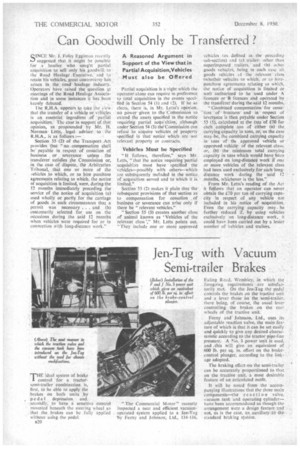Jen-Tug with Vacuum Semi-trailer Brakes
Page 54

If you've noticed an error in this article please click here to report it so we can fix it.
THE ideal system of brake control for a tractoesemi-trailer combination is. first, to be able to apply the brakes on both units by pedal depression. and. _secondly, to have a sensitive control mounted beneath the steering wheel so that the brakes can be fully applied without using the pedal.
e20 " The Commercial Motor" recently inspected a neat and efficient vacuumoperated system applied to a JereTug by Feeny and Johnson, Ltd., 134-136,
Ealing Road, Wembley., in which the foregoing requirements are satisfactorily met. On the Jen,Iug the pedal controls the brakes on the trective unit and a lever those On the semi-trailer. there being, of course, the usual lever controlling the brakes on the rear wheels of the tractive unit.
Feeny and' Johnson, Ltd., uses its adjustable reaction valve, the main feature of which is that it can be set easily and quickly to give any desired characteristic according to the tractor pipe-line pressure. A No. 3 power unit is used, and this will give an equivalent or 6430 lb. per sq. in. effort on the brakecontrol plunger, according to the linkage adopted.
The braking effect-on the semi-trailey can be accurately proportioned to that on the tractive unit, a most desirable feature of an articulated outfit.
It will be noted from the accompanying illustrations that the three main components—the reaeti on valve, vacuum tank and operating cylinder— have been accommodated as though the arrangement were a design feature and not, as is the case, eneauxitiare tO the standard braking sestem.




























































































